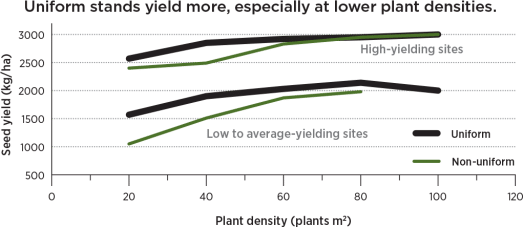Market and environmental challenges often have farmers reviewing ways to best-manage inputs to improve profits. Here are common agronomy practices that can greatly influence crop profitability.
Seed right the first time
Canola growers have four good economic reasons to focus on good seed placement:
- Consistent canola seed placement at a uniform depth improves seed survival and the return on seed investment. Targeting 5 to 8 plants per square foot gives the crop a better chance to meet its yield potential. Research conducted at AAFC demonstrated that a non-uniform plant stand of less than 6 plants per square foot gave up nearly 20% yield compared to a uniform plant stand with the same number of plants. This effect evaporated at 8 plants per square foot.
- A crop with quicker canopy closure can eliminate the need for a second in-crop herbicide application.
- A stand at the higher end of the recommended 5 to 8 plants per square foot leaves growers a little leeway when it comes to disease and insect management decisions, knowing that losing a plant or two per square foot will not reduce yield potential.
- A uniform plant stand of 5 to 8 plants per square foot could mature a little faster than a thinner stand, which will branch out more. The more branches, the longer it takes for all seeds to mature. READ MORE

Choose an appropriate seeding rate
A uniform early-established canola stand of 5 to 8 plants per square foot usually yields better than thinner, later or uneven stands. Economic considerations for 5 to 8 versus 2 to 3 plants per square foot start with seed cost and yield potential.
–Seed cost. Assuming 60 per cent seed survival, 5g/1,000 seed size and $12 per pound seed cost, seeding to target five to eight plants per square will cost $48.00 to $76.80 per acre. With the same parameters, seeding to target two to three plants per square foot will cost $19.20 to $28.80 per acre. The difference between mid-points of the two targets would be around $35 to $40 per acre. Try to think beyond the immediate seed savings and remember that extra plants = extra insurance. And less plants = more risk and lower yields and later maturity Use the Canola Calculator to run your own numbers. More on cost: An AAFC inputs study found that choosing a non-hybrid conventional canola reduced net returns compared to hybrid canola. Manitoba Canola Growers’ open-pollinated (OP) canola trials from 2016 and 2017 found a significant gap in yield potential between common hybrids and top performing OP canola varieties.
–Yield. We know that plant stands of less than 4 plants per square foot lose yield and yield predictability. Set your target at 5 to 8 plants per square foot to set yourself up for optimum, predictable yields.
–Subjective factors. The big difference in profitability often comes from subjective factors that can reduce profit or increase risk or both. Thinner stands often lead to added yield loss from non-uniform establishment, higher weed management costs from reduce competition, more intense insect damage, and a wider range of crop staging and delayed maturity (which can make fungicide and harvest timing more challenging). READ MORE
Control weeds early
Early weed control is preferred because nutrient and moisture taken up by weeds means less for the crop. Weeds emerging before the crop also compete for sunlight, which is an issue if those weeds canopy over the crop. Ideally, growers want crop emerging in a clean field so it can get ahead of the weed competition. That is why pre-seed and early in-crop control are so valuable. Economically, if a farmer budgets for two sprays, yield and profits can be increased by applying those same applications early versus late. An AAFC inputs study, which analyzed data from field studies, underlined the value of weed control. “Without weed control, all other major inputs will not pay off. Higher seeding rates of canola, higher fertilizer rates or better genetics cannot overcome the weed competition.” READ MORE
Meet crop needs for fertilizer
Nitrogen is the single biggest fertilizer input for canola, and growers may be able to trim some cost by adjusting their target along the nitrogen response curve. Perhaps instead of a 1:1 cost versus return ratio on the last pound of nitrogen applied, the approach in a year that starts off with dry soils and lower price outlooks might be a 1:1.5 or 1:2 cost versus return for the last pound of nitrogen. (Click here for more on nitrogen economics and links to calculators. See below for an article from John Heard on how to use the N economics calculator.) The AAFC input study referenced in the weeds section also compared net returns when N fertilizer was reduced by 50% and 100% from the recommended rate. For the 50% reduction, net returns were fairly close to the average net returns for strips getting the highest level of inputs. This suggests a short term possibility to reduce fertilizer inputs — as long as fertilizer applications in the past had built up a decent baseline level. How much fertilizer does canola need?